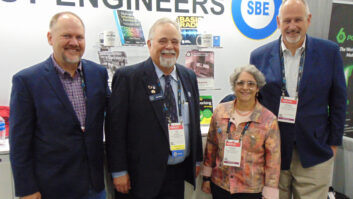Gather a bunch of working broadcast engineers in a room, and two things are almost inevitable. First, the median age of the group will probably be somewhere well north of 50; and second, they’ll spend some time bemoaning the lack of younger engineers entering the business.
Leaders of the NAB and the Society of Broadcast Engineers tried to address this conundrum during the NAB Show in Las Vegas in April, with a Broadcast Engineering Conference discussion about the future of radio engineering as a career.
One of the biggest challenges for would-be engineers, says SBE Executive Director John Poray, is the reduced number of jobs in the field.
“There are fewer technical jobs in broadcasting today than in the past,” Poray said, citing Bureau of Labor Statistics research that shows the number of broadcast “establishments” (separate workplaces) dropping from 10,287 in 2001 to 9,739 in 2011 – a five percent decline. In 1999, the BLS reported that 25,570 people were working in technical jobs at radio and TV stations, but by 2008, that number dropped to 22,200.
Some of that decrease can be blamed on deregulation and ownership consolidation, but Poray says that’s not the only factor. Another important consideration, he said, was the changing nature of the engineering field itself.
“When I get a call from a would-be employer, there are two questions,” he said. “Where can I find a broadcast engineer, and do I hire somebody with an IT background, an RF background or both?”
ADDRESSING THE AGE BUBBLE
As broadcast technology increasingly focuses on IT skills instead of the traditional RF specialties, Poray says there’s a growing shortage of engineers both willing and able to take on the jobs that remain.
Over the last decade, he says, broadcast engineers haven’t been as willing to change markets to advance in a career in the field, in part because of the increasing value of their IT expertise.

“There was less of a desire to move from one market to another, and consolidation reduced engineering jobs. If they were cut from the industry, they left rather than move towns. They could take their skills (to other industries) and do just as well,” Poray said.
That’s a challenge to employers as well; Poray says many can’t afford the engineers who are available, since they’re looking for “financial incentives” to leave situations and communities where they’ve become comfortable.
As the scope of a broadcast engineer’s duties expands, some engineers say employers are simply setting the bar too high to find the candidates they need. Rich Parker, director of engineering at Vermont Public Radio, says many employers are now asking for advanced degrees along with an unrealistic level of RF and IT experience.
“You see a lot of job postings these days where the only thing that’s left out is, ‘Can you walk on water and fix the toilets,’” Parker said, noting that wireless telecommunications carriers are grabbing many engineers with those skill sets who’d once have been limited to traditional broadcasting jobs.
Of the engineers who have remained in the broadcast business, Poray says SBE research shows a significant age gap: While almost 28 percent of working engineers were between the ages of 35 – 46 in 2001, only 14 percent were in that age bracket in 2011.

At the other end of the age spectrum, about a quarter of all working broadcast engineers in 2001 were 56 or older, a number that had ballooned to 42 percent a decade later – a reflection that many older engineers have simply stayed put instead of retiring.
That, says Poray, is partially a reflection of a dwindling pool of potential replacements for older engineers seeking to leave the business.
“There are fewer jobs, but there are jobs available. Often there are not enough qualified candidates, and jobs go unfilled,” Poray said, adding “a more severe shortage is probably coming in the next 10 years, if not sooner.”
The SBE’s own enrollment numbers provide some insight into the shrinking number of new engineers. Poray says among all professional organizations nationwide, the average age of new members is in their mid-30s. Among the 500 to 600 new members the SBE enrolls each year, though, he says only 25 percent are under age 31.
The organization has been trying to address the problem in several ways, including the SBE Jobs Online program. The program is free to employers posting their openings, but only SBE members have access to the full job postings. The SBE’s resume service also allows members to post their resumes anonymously; employers interested in a particular resume can obtain full contact information by paying a small fee to SBE.
The SBE is also working with the NAB Education Foundation (NABEF) on a Technology Apprentice Program. The six-month program for interested college seniors includes a summer internship at a broadcast facility, a visit to the NAB Show and the opportunity to take the SBE’s Certified Broadcast Technician (CBT) examination.
‘A SELF-CURING PROBLEM’
Veteran engineer Fred Baumgartner, who’s now the director of broadcast operations at Harris Corp., says that throughout the history of broadcasting, there has always been an opportunity for the most skilled, most talented engineers to find good jobs.
“The guys I knew at the top end of the broadcast spectrum made a lot more than electronic engineers did,” Baumgartner said. So while lower-end jobs and unpaid internships may end up sitting empty, Baumgartner believes “no real broadcast engineering jobs will go unfilled.”
“The truth of the matter is, it is a supply and demand issue,” he said. “If the demand is there, it attracts more people to the industry. It’s a self-curing problem; I’m not going to worry about the next generation of broadcast engineers.”
Based in Rochester, N.Y., Scott Fybush is the editor of NorthEast Radio Watch and a longtime RW contributor.











